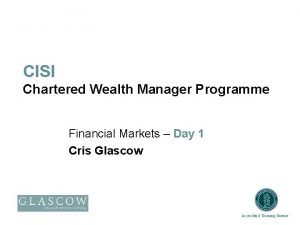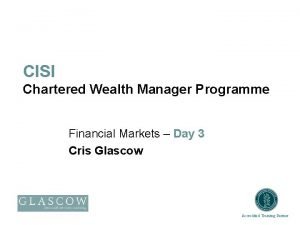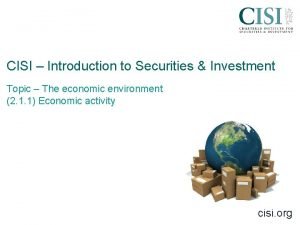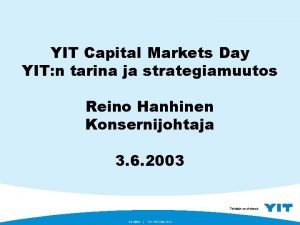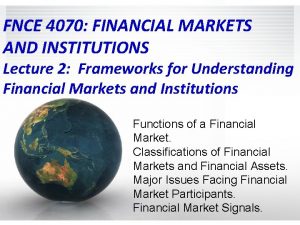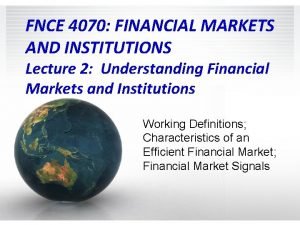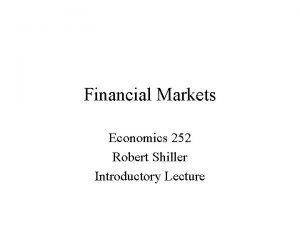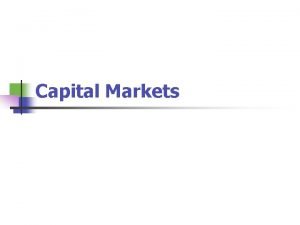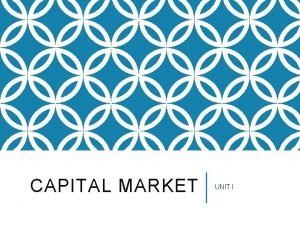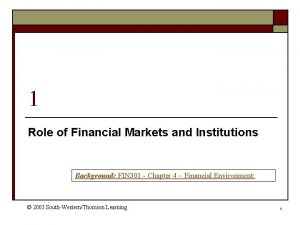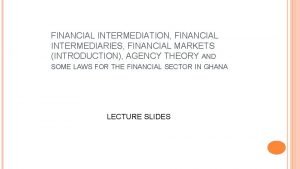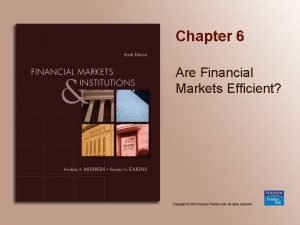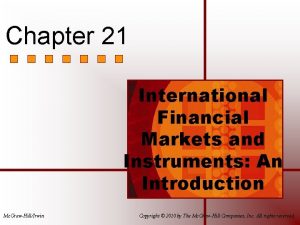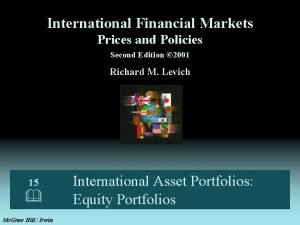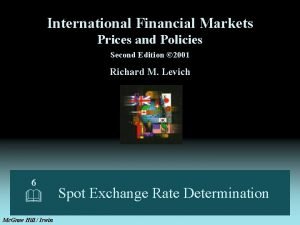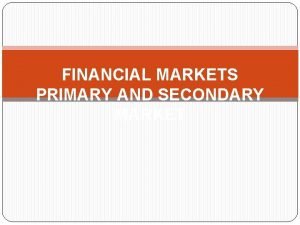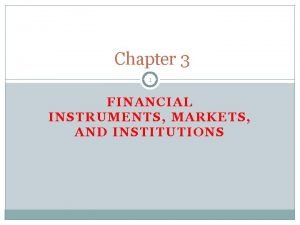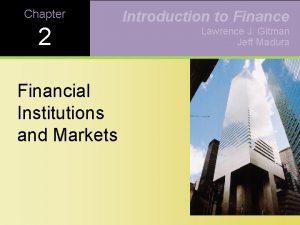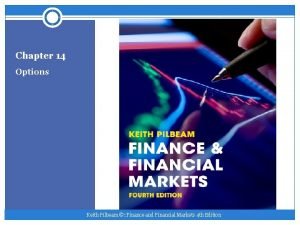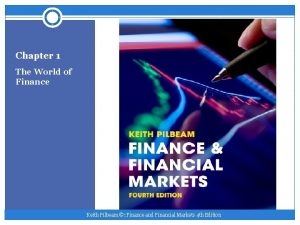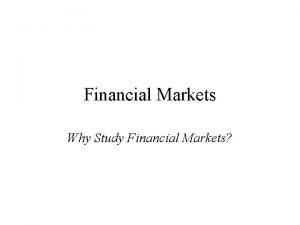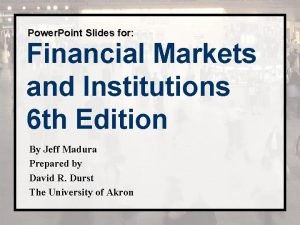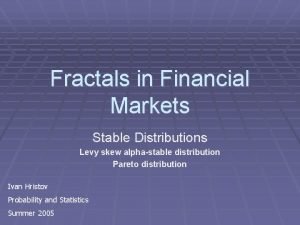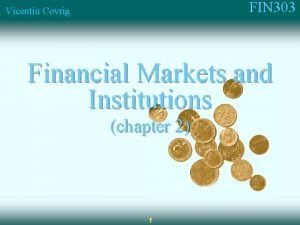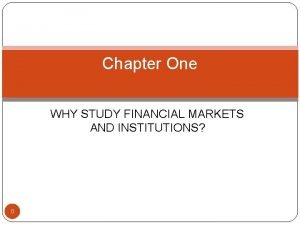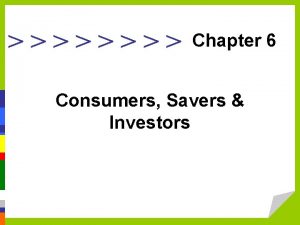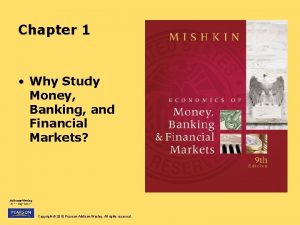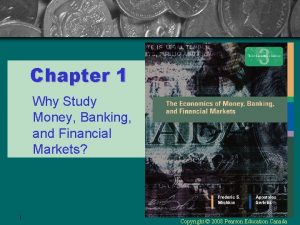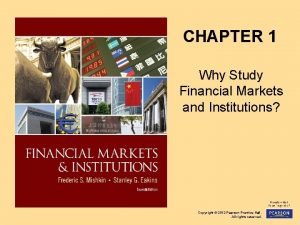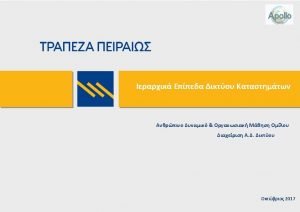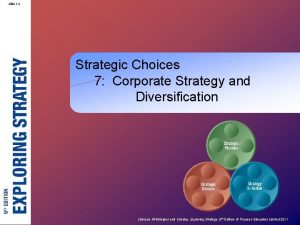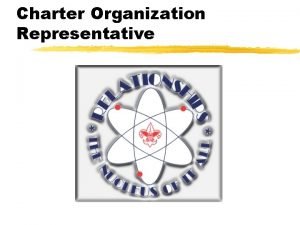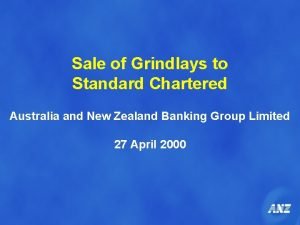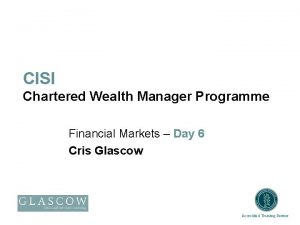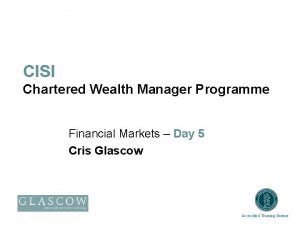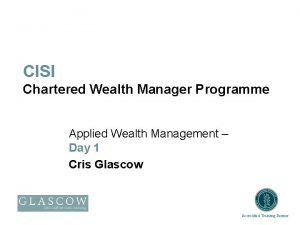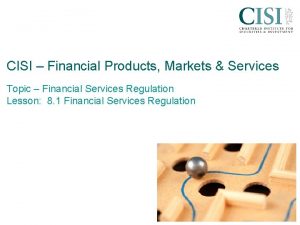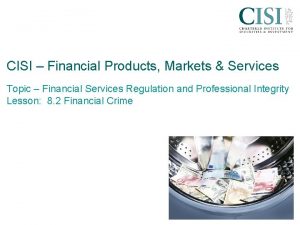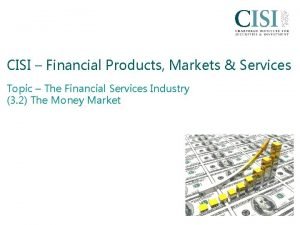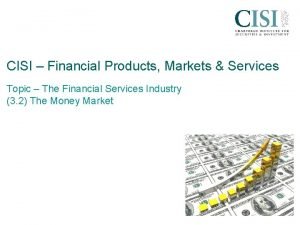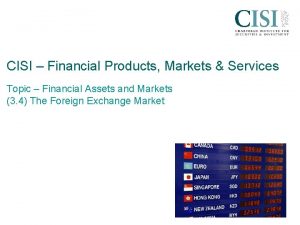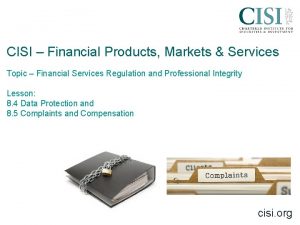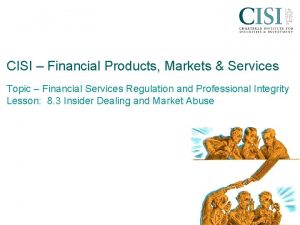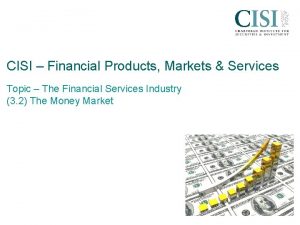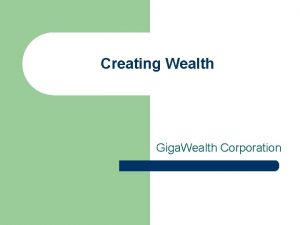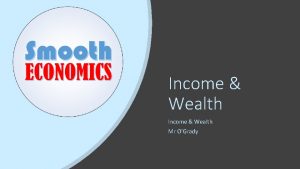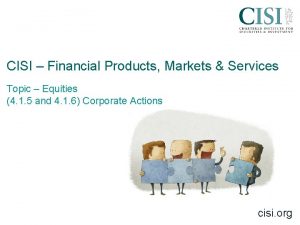CISI Chartered Wealth Manager Programme Financial Markets Day





















































- Slides: 53

CISI Chartered Wealth Manager Programme Financial Markets – Day 1 Cris Glascow Accredited Training Partner

Objectives By the end of the workshop you will have: q Revised learning outcomes 1 and 2 q Practised exam type questions q Identified areas you need to read about more thoroughly q Devised an action plan. Accredited Training Partner

Agenda q q The Financial Markets exam Module 1 Module 2 Review. Accredited Training Partner

General points about the Financial Markets exam: The CISI state: q q q There are no common themes to the questions All subject matter in the syllabus can be tested Some information can be tested in Section A short questions or it may form part of the larger questions in Sections B & C. Ref: Exam tips - http: //glascow. co. uk/whats-the-best-way-to-ensurethat-you-pass-the-cisis-financial-markets-exam/ http: //glascow. co. uk/benefits-of-structured-study-to-pass-an-exam/ Accredited Training Partner

5 point plan to do well in this exam: 1. 2. 3. 4. Plan your study time Know the syllabus content Understand the concepts Apply key concepts to scenarios and case studies 5. Practise answering questions. Current pass rate: 45% (48% December 2017, 47% June 2017, 40% December 2016) Accredited Training Partner

Module 1 – Macro Economics and Macro Economic Policy Accredited Training Partner

Economic Policy q The task of economics is to foster economic growth which will then lead to greater social welfare and happiness. q According to Alfred Marshall (1842 -1924) in his book Principles of Economics: “Political economy or economics is the study of mankind in the ordinary business of life; it examines that part of the individual and social action which is most connected with the attainment and with the use of the material requisites of wellbeing. ” Accredited Training Partner

Basics economic factors q Land - rent q Labour – wages / salaries q Capital – interest / rent q Enterprise – profits (losses) Accredited Training Partner

The Circular Flow of the Economy – Production / Output Cycle FIRMS Firms acquire factors of production from households Firms produce goods and services for households to consume HOUSEHOLDS Accredited Training Partner

The Circular Flow of the Economy – Income / Expenditure Cycle FIRMS Firms pay money in return for factors of production from households Firms receive money in return for goods and services HOUSEHOLDS Accredited Training Partner

The Circular Flow of the Economy – The Modified Output / Income Flow Diagram FIRMS LEAKAGES INJECTIONS HOUSEHOLDS Accredited Training Partner

Other key economic concepts q Opportunity cost q Marginal concepts. Accredited Training Partner

Demand supply How does Price Affect Demand? q Let’s assume that a television costs £ 400 q The price is reduced to £ 200 q Show the effect of the price change on a diagram. Accredited Training Partner

What Else Affects Demand? q q q q Income Price of substitutes Price of complimentary goods Tastes and expectations Demographics Advertising New technology. Accredited Training Partner

Price Elasticity of Demand q In most cases, a price increase leads to a decrease in demand q A price decrease leads to an increase in demand q “Giffen goods” and “Veblen goods” are the exception. Accredited Training Partner

Price Elasticity of Demand - formula PED = Percentage change in quantity demanded Percentage change in the price charged At the price of £ 80, 100, 000 products are demanded. The price increases to £ 120, and demand reduces to 60, 000 products. What is the price elasticity of demand? Accredited Training Partner

Price Elasticity of Demand - What it means q A PED of zero Revenue is unaffected – zero elasticity q A PED of less than 1 A positive growth can be maintained – low elasticity q A PED of exactly 1 A stable sales revenue – unit elasticity q A PED of more than 1 – higher elasticity q However, other factors must be considered eg. substitutes, incomes, necessity, habits and time. Handout 1 Accredited Training Partner

Supply Diagrams q The supply curve line is upward sloping q As price increases, there is an incentive for a firm to supply more leading to an expansion in supply q If price reduces, firms will have less incentive to produce and supply will normally contract q A firm produces 2, 000 units, sold at £ 200 each. Due to market forces, the price reduces to £ 160 per unit. Show what the effect may be on a supply diagram. Accredited Training Partner

Equilibrium Price q The equilibrium price is the market price – set by the invisible hand. q This is indicated where demand supply lines cross. q There is no need for change. Accredited Training Partner

Different Market Systems q Planned q Free Market q Mixed. EXAM PRACTICE QUESTION – Briefly describe the key differences between a planned economy, a free market economy and a mixed economy? Accredited Training Partner

Keynesian Economics (1) q John Maynard Keynes (1883 -1946) q The time of the 1930 s Great Depression q The General Theory of Employment, Interest and Money, 1936 q Government intervention to spend more than it received through taxes to kick start the economy. Ref: John Maynard Keynes: www. youtube. com/watch? v=h. EYd. S 5 s. UR 90 Accredited Training Partner

Keynesian Economics (2) q q q Aggregate level of demand Marginal propensity to consume Marginal propensity to save Aggregate monetary demand Multiplier effect Paradox of thrift. Accredited Training Partner

Monetarism q q Milton Friedman 1912 -2006 Seminal work - Capitalism and Freedom 1962 Markets should work efficiently and self-correct Keynesian intervention distorted true supply and demand q Freidman believed that manipulation of aggregate demand increased money supply led for example, to stagflation in the 1970 s. Accredited Training Partner

The Business Cycle Economy Boom Recession Time Accredited Training Partner

Inflation q q q Monetarists believe that inflation distorts markets It must be addressed before any other economic issues In the UK, control is the responsibility of the MPC at the Bank of England They meet monthly and decide whether to change interest rates The target is set at 2%. Ref: Control of inflation in UK http: //www. bankofengland. co. uk/publications/Pages/inflationreport/defa ult. aspx Handout 2 – Inflation exercises Accredited Training Partner

Who Sets Interest Rates? q The Bank of England q Aware of money market activities q Traders look at growth in GDP, employment and inflation q Risk of inflation will encourage traders to push up rates to ensure a real return. Accredited Training Partner

Case Study – Interest rate changes and effects on business Accredited Training Partner

High Inflation q q q Consumers have less spending power Investments may not keep up with inflation Prices can become unstable Higher nominal interest rates Lower real interest rates Incentive to lend lessens. Discussion point – impact on prices and returns for assets such as bonds and equities Accredited Training Partner

Deflation q q q Deflation – actual drops in prices Demand drops – people delay buying Reduces business and investment returns Leads to a “deflationary spiral” Real value of debt goes up. Ref: Bank of England speech on deflation – http: //www. bankofengland. co. uk/publications/Documents/speeche s/2015/speech 813. pdf Accredited Training Partner

Quantity theory of money q Quantity theory of money is MV = PT where: q M = the money supply (the stock of money) q V = the velocity of circulation q P = the average price of a transaction in a period q T = the number of transactions that take place in a period. Accredited Training Partner

Supply Side Economics q Monetarist view that by removing supply side restrictions, the free market can work properly q Barriers to employment e. g. Immobilisation of labour, trade union restrictions q Barriers to international trade q Tax – The Laffer Curve. Accredited Training Partner

The Yield Curve q A combination of expectations theory, liquidity preference theory and market segmentation theory. Accredited Training Partner

Fiscal Policy q Government spending and taxation q Public Sector Net Cash Requirement (PSNCR) q Keynesians believe in stimulating demand to avoid a deflationary spiral and are less concerned with PSNCR q Monetarists believe the deficit will lead to inflation and higher interest rates. Ref: UK Government spending and debt: http: //www. ukpublicspending. co. uk/uk_national_deficit_analysis Accredited Training Partner

Monetary Policy q q M 0, M 2, M 4 Sterling market operations Direct credit controls Quantitative easing. Handout 3 – QE exercises Accredited Training Partner

Exchange Rates (1) q Floating exchange rates q Mainly based on banks trading between themselves and the forex market q Central banks will try to guide markets q The system allows for natural adjustment. Discussion point – other exchange rate systems Accredited Training Partner

Exchange Rates (2) Case Study – BV technologies Accredited Training Partner

Exchange Rates (3) q PPP q Big Mac Index q International Fisher Theory. Accredited Training Partner

Summary of macro-economic statistics q q q q Inflation (see earlier) Labour and employment data Misery index GDP and GNP Output gap Balance of payments Balance of trade Consumer confidence. Accredited Training Partner

Financial Markets and Services q q q Role of capital markets Capital market instruments – stocks and shares Derivatives Money markets Bank of England Financial intermediaries. Accredited Training Partner

Module 2 - Financial Statements Accredited Training Partner

Basic Accounting Principles (1) Dual aspect concept: q Assets = liabilities + capital q Assets - liabilities = capital. Handout 4 – Dual aspect accounting Accredited Training Partner

Basic Accounting Principles (2) Money measurement concept q Every recorded transaction is measured in money q The measuring unit principle. Accredited Training Partner

Basic Accounting Principles (3) Accounting entity concept: q Financial records prepared for a distinct entity regarded as separate from the individuals that own the business. Accredited Training Partner

Basic Accounting Principles (4) Going concern concept q The principle that the business will be in existence for the foreseeable future q Where company is not a going concern, the break up basis is used - assets and liabilities are calculated at their net realisable value. Accredited Training Partner

Basic Accounting Principles (5) Accruals concept: q Revenues and expenses recognised when accrued regardless of when cash is paid. Accredited Training Partner

Basic Accounting Principles (6) Matching principle: q Costs incurred for the current period are matched against current period q Pre-payments against future periods should be carried forward q Expenses are recognised when the obligation is incurred i. e. date of transfer of goods and services. Accredited Training Partner

Basic Accounting Principles (7) Prudence: q Accounting should exhibit conservatism q Values should be chosen that result in a lower profit / asset value against higher liability values. Accredited Training Partner

Basic Accounting Principles (8) Consistency and comparability: q Accounting of the business should continue to use assumptions such as depreciation year in the same way q If assumptions are altered, an explanation will need to be given as well as the effects of the change. Accredited Training Partner

Basic Accounting Principles (9) Subsidiary company accounting and overseas business: q Care needed when consolidating accounts from overseas subsidiaries q Principal concern is the basis on which currency conversion takes place between parent company (domestic currency) and subsidiary (overseas currency) q Do not alternate between different conversion protocols. Accredited Training Partner

Construction of Company Accounts Exercise q Balance sheet q Profit and loss account q Cash flow statement. Handout 5 – Construction of accounts Accredited Training Partner

Accounting Standards (1) Stakeholders who benefit from financial statements include: q Internal stakeholders - owners, directors, managers and employees q External stakeholders - investors, financial institutions, Government entities, media and the general public. Accredited Training Partner

Accounting Standards (2) Generally accepted accounting principles (GAAP) q Guidelines that form the basis in the preparation of financial statements q Move from UK GAAP towards adoption of International Accounting Standards q Differences between UK and International accounting Standards still exist. Accredited Training Partner

Day 1 Review q Review slides and exercises against syllabus q Check areas of understanding - questions for next session q Assess past exam reports for questions on syllabus areas covered. Accredited Training Partner
 Chartered wealth manager cisi
Chartered wealth manager cisi Cisi discount code
Cisi discount code Cisi wealth management
Cisi wealth management Day 1 day 2 day 3 day 4
Day 1 day 2 day 3 day 4 Day 1 day 2 day 817
Day 1 day 2 day 817 Financial service partners
Financial service partners Cisi introduction to securities and investment
Cisi introduction to securities and investment Aktutor.in mcq
Aktutor.in mcq Metsä board osinko
Metsä board osinko Why study financial institutions
Why study financial institutions Money market participants
Money market participants Classification of financial markets
Classification of financial markets Financial market classification
Financial market classification Shiller financial markets
Shiller financial markets Classification of financial markets
Classification of financial markets Classification of financial markets
Classification of financial markets Functions of financial markets and institutions
Functions of financial markets and institutions Financial intermediaries ppt
Financial intermediaries ppt Financial intermediary
Financial intermediary Are financial markets efficient
Are financial markets efficient International financial markets and instruments
International financial markets and instruments Capital markets and financial intermediation
Capital markets and financial intermediation Levich international financial markets
Levich international financial markets Levich international financial markets
Levich international financial markets Difference between primary and secondary market
Difference between primary and secondary market Financial markets and the allocation of capital
Financial markets and the allocation of capital Types of exchange rate
Types of exchange rate Financial markets instruments and institutions
Financial markets instruments and institutions Madura j. financial markets and institutions
Madura j. financial markets and institutions Pilbeam k. finance and financial markets
Pilbeam k. finance and financial markets Keith pilbeam
Keith pilbeam Classification of financial markets
Classification of financial markets Madura j. financial markets and institutions
Madura j. financial markets and institutions Fractals in financial markets
Fractals in financial markets Well functioning financial markets
Well functioning financial markets Why study financial markets and institutions
Why study financial markets and institutions Chapter 6 consumers savers and investors
Chapter 6 consumers savers and investors Why study money banking and financial markets
Why study money banking and financial markets Why study money banking and financial markets
Why study money banking and financial markets Why study financial markets
Why study financial markets Midday meal scheme kerala
Midday meal scheme kerala Senior manager vs general manager
Senior manager vs general manager Portfolio manager synergy manager parental developer
Portfolio manager synergy manager parental developer The hong kong institute of chartered secretaries
The hong kong institute of chartered secretaries Chartered institute of water environment management
Chartered institute of water environment management Chartered developments
Chartered developments Lost at the sea ranking chart
Lost at the sea ranking chart Initial professional development
Initial professional development Cgeol
Cgeol Chartered scientist
Chartered scientist Bcs student membership
Bcs student membership Chartered organization representative
Chartered organization representative Standard chartered australia
Standard chartered australia Chartered secretaries southern africa
Chartered secretaries southern africa
